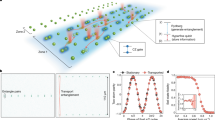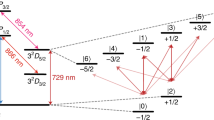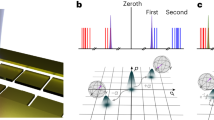Abstract
Quantum computers promise to efficiently simulate quantum dynamics, a classically intractable task central to fields ranging from chemistry to high-energy physics. Yet, quantum computational advantage has only been demonstrated for artificial tasks such as random circuit sampling, and hardware limitations and noise have limited experiments to qualitative studies of small-scale systems. Quantum processors capable of high-fidelity measurements and qubit reuse enable a recently proposed holographic technique that employs quantum tensor-network states, a class of states that efficiently compress quantum data, to simulate the evolution of infinitely long, entangled initial states using a small number of qubits. Here we benchmark this holographic technique in a trapped-ion quantum processor using 11 qubits to simulate the dynamics of an infinite entangled state. We observe the hallmarks of quantum chaos and light-cone propagation of correlations, and find excellent quantitative agreement with theoretical predictions for the infinite-size limit of the implemented model with minimal post-processing or error mitigation. These results show that quantum tensor-network methods, paired with state-of-the-art quantum processor capabilities, offer a viable route to practical quantum computational advantage on problems of direct interest to science and technology in the near term.
This is a preview of subscription content, access via your institution
Access options
Access Nature and 54 other Nature Portfolio journals
Get Nature+, our best-value online-access subscription
$29.99 / 30 days
cancel any time
Subscribe to this journal
Receive 12 print issues and online access
$209.00 per year
only $17.42 per issue
Buy this article
- Purchase on Springer Link
- Instant access to full article PDF
Prices may be subject to local taxes which are calculated during checkout



Similar content being viewed by others
Data availability
The raw data produced by the Quantinuum devices for this work are available in Supplementary Data 1.
Code availability
The code used to generate data for this work is available from the corresponding author upon reasonable request.
References
D’Alessio, L., Kafri, Y., Polkovnikov, A. & Rigol, M. From quantum chaos and eigenstate thermalization to statistical mechanics and thermodynamics. Adv. Phys. 65, 239–362 (2016).
Abanin, D. A., Altman, E., Bloch, I. & Serbyn, M. Colloquium: many-body localization, thermalization, and entanglement. Rev. Mod. Phys. 91, 021001 (2019).
Lloyd, S. Universal quantum simulators. Science 273, 1073–1078 (1996).
Childs, A. M., Maslov, D., Nam, Y., Ross, N. J. & Su, Y. Toward the first quantum simulation with quantum speedup. Proc. Natl. Acad. Sci. USA 115, 9456–9461 (2018).
Gross, C. & Bloch, I. Quantum simulations with ultracold atoms in optical lattices. Science 357, 995–1001 (2017).
Monroe, C. et al. Programmable quantum simulations of spin systems with trapped ions. Rev. Mod. Phys. 93, 025001 (2021).
Browaeys, A. & Lahaye, T. Many-body physics with individually controlled Rydberg atoms. Nat. Phys. 16, 132–142 (2020).
Kim, I. H. Holographic quantum simulation. Preprint at https://arxiv.org/abs/1702.02093 (2017).
Kim, I. H. and Swingle, B. Robust entanglement renormalization on a noisy quantum computer. Preprint at https://arxiv.org/abs/1711.07500 (2017)
Foss-Feig, M. et al. Holographic quantum algorithms for simulating correlated spin systems. Phys. Rev. Research 3, 033002 (2021).
Liu, J.-G., Zhang, Y.-H., Wan, Y. and Wang, L. Variational quantum eigensolver with fewer qubits. Phys. Rev. Res. 1, 023025 https://journals.aps.org/prresearch/abstract/10.1103/PhysRevResearch.1.023025 (2019).
Barratt, F. et al. Parallel quantum simulation of large systems on small quantum computers. NPJ Quantum Inf. 7, 79 https://www.nature.com/articles/s41534-021-00420-3 (2020).
Lin, Sheng-Hsuan, Dilip, R., Green, A. G., Smith, A. & Pollmann, F. Real- and imaginary-time evolution with compressed quantum circuits. PRX Quantum 2, 010342 (2021).
Smith, A., Jobst, B., Green, A. G. and Pollmann, F. Crossing a topological phase transition with a quantum computer. Phys. Rev. Res. 4, L022020 https://journals.aps.org/prresearch/abstract/10.1103/PhysRevResearch.4.L022020 (2019).
Yuan, X., Sun, J., Liu, J., Zhao, Q. and Zhou, Y. Quantum simulation with hybrid tensor networks. Phys. Rev. Lett. 127, 04051 https://journals.aps.org/prl/abstract/10.1103/PhysRevLett.127.040501 (2020).
Eddins, A. et al. Doubling the size of quantum simulators by entanglement forging. PRX Quantum 3, 010309 https://journals.aps.org/prxquantum/abstract/10.1103/PRXQuantum.3.010309 (2021).
Bravo-Prieto, C., Lumbreras-Zarapico, J., Tagliacozzo, L. & Latorre, JoséI. Scaling of variational quantum circuit depth for condensed matter systems. Quantum 4, 272 (2020).
Calabrese, P. & Cardy, J. Evolution of entanglement entropy in one-dimensional systems. J. Stat. Mech. 2005, P04010 (2005).
Schön, C., Solano, E., Verstraete, F., Cirac, J. I. & Wolf, M. M. Sequential generation of entangled multiqubit states. Phys. Rev. Lett. 95, 110503 (2005).
Huggins, W., Patil, P., Mitchell, B., Whaley, K. B. & Stoudenmire, E. M. Towards quantum machine learning with tensor networks. Quantum Sci. Technol. 4, 024001 (2019).
Akila, M., Gutkin, B. & Guhr, T. Particle-time duality in the kicked Ising spin chain. J. Phys. A: Math. Theor. 49, 375101 (2016).
Bertini, B., Kos, P. & Prosen, T. Exact spectral form factor in a minimal model of many-body quantum chaos. Phys. Rev. Lett. 121, 264101 (2018).
Bertini, B., Kos, P. & Prosen, T. Exact correlation functions for dual-unitary lattice models in 1 + 1 dimensions. Phys. Rev. Lett. 123, 210601 (2019).
Gopalakrishnan, S. & Lamacraft, A. Unitary circuits of finite depth and infinite width from quantum channels. Phys. Rev. B 100, 064309 (2019).
Piroli, L., Bertini, B., Cirac, J. I. & Prosen, T. Exact dynamics in dual-unitary quantum circuits. Phys. Rev. B 101, 094304 (2020).
Bertini, B., Kos, P. & Prosen, T. Operator entanglement in local quantum circuits I: chaotic dual-unitary circuits. SciPost Phys. 8, 067 (2020).
Claeys, P. W. & Lamacraft, A. Ergodic and nonergodic dual-unitary quantum circuits with arbitrary local Hilbert space dimension. Phys. Rev. Lett. 126, 100603 (2021).
Barrett, M. D. et al. Deterministic quantum teleportation of atomic qubits. Nature 429, 737–739 (2004).
Chiaverini, J. et al. Realization of quantum error correction. Nature 432, 602–605 (2004).
Olmschenk, S. et al. Manipulation and detection of a trapped Yb+ hyperfine qubit. Phys. Rev. A 76, 052314 (2007).
Berkeland, D. J., Miller, J. D., Bergquist, J. C., Itano, W. M. & Wineland, D. J. Minimization of ion micromotion in a Paul trap. J. Appl. Phys. 83, 5025–5033 (1998).
Fishman, M., White, S. R. and Stoudenmire, E. M. The ITensor software library for tensor network calculations. Preprint at https://arxiv.org/abs/2007.14822 (2020).
Claeys, P. W. & Lamacraft, A. Maximum velocity quantum circuits. Phys. Rev. Research 2, 033032 (2020).
Zaletel, M. P. & Pollmann, F. Isometric tensor network states in two dimensions. Phys. Rev. Lett. 124, 037201 (2020).
Pino, J. M. et al. Demonstration of the trapped-ion quantum CCD computer architecture. Nature 592, 209–213 (2021).
Palmero, M., Bowler, R., Gaebler, J. P., Leibfried, D. & Muga, J. G. Fast transport of mixed-species ion chains within a Paul trap. Phys. Rev. A 90, 053408 (2014).
Home, J. P. & Steane, A. M. Electrode configurations for fast separation of trapped ions. Quantum Inf. Comput. 6, 289–325 (2006).
Splatt, F. et al. Deterministic reordering of 40Ca+ ions in a linear segmented Paul trap. New J. Phys. 11, 103008 (2009).
Bezanson, J., Edelman, A., Karpinski, S. & Shah, V. B. Julia: a fresh approach to numerical computing. SIAM Rev. 59, 65–98 (2017).
Abraham, H. et al. Qiskit: an open-source framework for quantum computing. Zenodo https://zenodo.org/record/2562111 (2019).
Acknowledgements
This work was made possible by a large group of people, and the authors would like to thank the entire Quantinuum team for their many contributions. The experiments reported in this manuscript were performed on Quantinuum’s H1-1 and H1-2 system models, which are powered by Honeywell ion traps. We thank C. Baldwin for helpful discussions regarding the performance benchmarks on H1-1 and H1-2. We used the ITensor library32, written in Julia39, to perform the tensor-network contractions to generate the theory curves. Quantum circuits were prepared and simulated using the Qiskit library created by IBM40. A.C.P. was supported by NSF Convergence Accelerator Track C award 2040549.
Author information
Authors and Affiliations
Contributions
E.C., M.F.-F. and A.C.P. conceived the experiment. J.B., D.F., J.G., D.G., A.H., K.L., B.N. and R.S. executed the experiment on the Quantinuum quantum computer. E.C. performed the theoretical analysis and numerical simulations. E.C., M.F.-F. and A.C.P. analysed the experimental data. M.F.-F. and D.H. coordinated and supervised the project. E.C., M.F.-F., A.C.P. and D.H. wrote the manuscript and the Supplementary Information. All the authors edited the manuscript.
Corresponding author
Ethics declarations
Competing interests
The authors declare no competing interests.
Peer review
Peer review information
Nature Physics thanks Luca Tagliacozzo and the other, anonymous, reviewer(s) for their contribution to the peer review of this work.
Additional information
Publisher’s note Springer Nature remains neutral with regard to jurisdictional claims in published maps and institutional affiliations.
Supplementary information
Supplementary Information
Supplementary Figs. 1–7, discussion and references.
Supplementary Data 1
Experimental data used to produce the figures in the manuscript.
Rights and permissions
About this article
Cite this article
Chertkov, E., Bohnet, J., Francois, D. et al. Holographic dynamics simulations with a trapped-ion quantum computer. Nat. Phys. 18, 1074–1079 (2022). https://doi.org/10.1038/s41567-022-01689-7
Received:
Accepted:
Published:
Issue Date:
DOI: https://doi.org/10.1038/s41567-022-01689-7
This article is cited by
-
Observation of transition from superfluorescence to polariton condensation in CsPbBr3 quantum dots film
Light: Science & Applications (2024)
-
Characterizing a non-equilibrium phase transition on a quantum computer
Nature Physics (2023)
-
Measurement-induced entanglement and teleportation on a noisy quantum processor
Nature (2023)
-
Optimal simulation of quantum dynamics
Nature Physics (2022)



